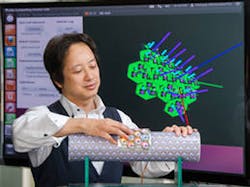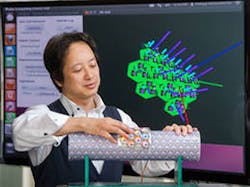Paralyzed Person In Robotic Exoskeleton Helps Kick Off World Cup
The Walk Again Project is an international collaboration of more than one hundred scientists, led by Prof. Miguel Nicolelis of Duke University and the International Institute for Neurosciences of Natal, Brazil. Prof. Gordon Cheng, head of the Institute for Cognitive Systems at the Technische Universitat Munchen (TUM), is a leading partner.
Eight Brazilian patients, men and women between 20 and 40 years of age who are paralyzed from the waist down, have been training for months to use the exoskeleton. The system works by recording electrical activity in the patient's brain, recognizing his or her intention “such as to take a step or kick a ball“ and translating that to action. It also gives the patient tactile feedback using sensitive artificial skin created by Cheng's institute.
Inspiration for this so-called CellulARSkin technology (see photo) ,as well as for the Walk Again Project itself, came from a 2008 collaboration. As Cheng sums up that complex and widely reported experiment, "Miguel set up a monkey walking on a treadmill in North Carolina, and then I made my humanoid robot walk with the signal in Kyoto." It was a short step for the researchers to envision a paralyzed person walking with the help of a robotic exoskeleton that could be guided by mental activity alone.”
"Our brains are very adaptive in the way that we can extend our embodiment to use tools," Cheng says, "as in driving a car or eating with chopsticks. After the Kyoto experiment, we felt certain that the brain could also liberate a paralyzed person to walk using an external body." It was clear that technical advances would be required to allow a relatively compact, lightweight exoskeleton to be assembled, and that visual feedback would not be enough. A sense of touch would be essential for the patient's emotional comfort as well as control over the exoskeleton. Thus the challenge was to give a paralyzed person, together with the ability to walk, the feeling of touching the ground.
Upon joining TUM in 2010, Cheng made it a research priority for his institute to improve on the state of the art in tactile sensing for robotic systems. The result, CellulARSkin, provides a framework for a robust and self-organizing surface sensor network. It can be implemented using standard off-the-shelf hardware and thus will benefit from future improvements in miniaturization, performance, and cost.
The basic unit is a flat, six-sided package of electronic components including a low-power-consumption microprocessor as well as sensors that detect pre-touch proximity, pressure, vibration, temperature, and even movement in three-dimensional space. Any number of these individual "cells" can be networked together in a honeycomb pattern, protected in the current prototype by a rubbery skin of molded elastomer.
s at the Technische Universitat Munchen (TUM) is enabling paralyzed patients to engage in human body movements.
About the Author

Sam Davis Blog
Editor-In-Chief - Power Electronics
Sam Davis was the editor-in-chief of Power Electronics Technology magazine and website that is now part of Electronic Design. He has 18 years experience in electronic engineering design and management, six years in public relations and 25 years as a trade press editor. He holds a BSEE from Case-Western Reserve University, and did graduate work at the same school and UCLA. Sam was the editor for PCIM, the predecessor to Power Electronics Technology, from 1984 to 2004. His engineering experience includes circuit and system design for Litton Systems, Bunker-Ramo, Rocketdyne, and Clevite Corporation.. Design tasks included analog circuits, display systems, power supplies, underwater ordnance systems, and test systems. He also served as a program manager for a Litton Systems Navy program.
Sam is the author of Computer Data Displays, a book published by Prentice-Hall in the U.S. and Japan in 1969. He is also a recipient of the Jesse Neal Award for trade press editorial excellence, and has one patent for naval ship construction that simplifies electronic system integration.


